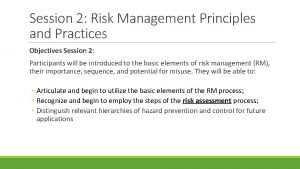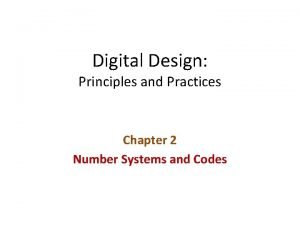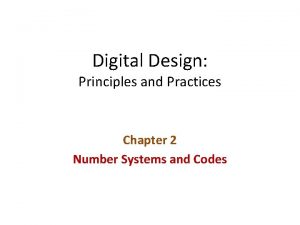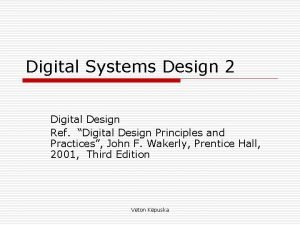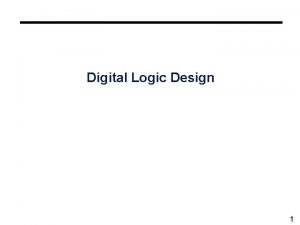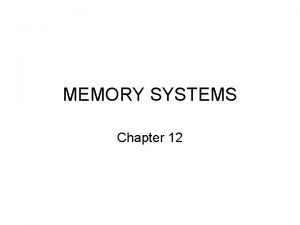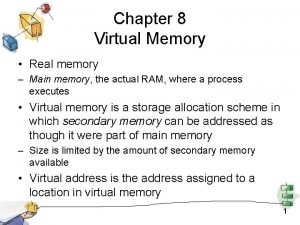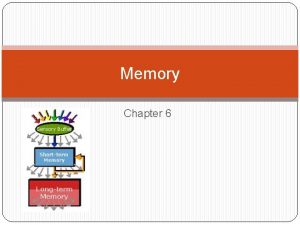Digital Design Principles and Practices Chapter 9 Memory


























- Slides: 26

Digital Design: Principles and Practices Chapter 9 Memory, CPLDs, and FPGAs

9. 1 Read-Only Memory

Read-Only Memory (ROM) • A read-only memory (ROM) is a combinational circuit with n inputs and b outputs. Ø The inputs are called address inputs and are traditionally named A 0, A 1, …, An-1. Ø The outputs are called data outputs and are typically named D 0, D 1, …, Db-1. 3

Read-Only Memory (ROM) • A ROM “stores” the truth table of an n-input, b-output combinational logic function. 4

Read-Only Memory (ROM) • A ROM is a combinational circuit Ø Not really a memory Ø Information is “stored” when a ROM is manufactured or programmed. • ROM is nonvolatile memory; that is, its contents are preserved even if no power is applied. 5

Nonvolatile Memory • ROM: hardwired during fabrication • PROM (programmable ROM): can be programmed once only Ø fuse • EPROM (Erasable PROM): can be erased by UV light, and can be re-programmed Ø Floating gate • EEPROM (Electrically Erasable PROM): can be erased with onchip circuitry Ø Floating gate • Flash memory: a variant of EEPROM that erases entire blocks rather than individual bits Ø Floating gate 6

Categories of Memory Arrays 7

Programmable ROMs • ROM has in practice become synonymous with nonvolatile, not read-only memory. • Programming/writing speeds are generally slower than read speeds. • Four type of nonvolatile memories: Ø Ø PROM (Programmable ROM) EPROM (Erasable Programmable ROM) EEPROM (Electrically Erasable Programmable ROM) Flash memories • PROMs us fuses while EPROMs, EEPROMs, and Flash use charge stored on a floating gate. 8

Floating Gate n. MOS Transistor 9

Floating Gate n. MOS Transistor • The floating gate is a good conductor, but it is not attached to anything. • Applying a high voltage to the upper gate causes electrons to jump through the thin oxide onto the floating gate. • Injecting the electrons induces a negative voltage on the floating gate, effectively increasing the threshold voltage (Vt) of the transistor to the point that it is always OFF. • EPROM: knock off the electrons off the floating gate by UV light • EEPROM and Flash can be erased electrically. 10

9. 2 Read/Write Memory

Read/Write Memory • The name read/write memory (RWM) is given to memory arrays in which we can store and retrieve information at any time. • Random-Access Memory (RAM) Ø Static RAM (SRAM) Ø Dynamic RAM (DRAM) 12

9. 3 Static RAM

Basic Structure of a n 2 x b RAM • CS: Chip Select • OE: Output Enable • WE: Write Enable • Read: CS and OE are asserted • Write: CS and WE are asserted 14

Internal Structure of an 8 x 4 SRAM 15

Functional Behavior of an SRAM Cell 16

12 -Transistor SRAM Cell 17

6 -Transistor (6 T) SRAM Cell 18

Stick Diagram of 6 T SRAM Cell 19

Layout of 6 T SRAM Cell Only poly and diff layers are shown. 20

9. 4 Dynamic RAM

DRAM Cell 22

DRAM Cell • A DRAM cell contains a transistor and a capacitor. • A basic DRAM cell is substantially smaller than a SRAM cell, but the cell must be periodically read and refreshed so that its contents do not leak away. • One a read, the bitline is first precharged to VDD/2. When the wordline rises, the capacitor shares its charge with the bitline, causing a voltage change △V that can be sensed. The read process disturbs the cell contents at x, so the cell must be rewritten after each read. [Figure 11. 26] Ø Sense amplifier 23

DRAM Cell – Read Operation 24

DRAM’s Capacitor 25

DRAM’s Capacitor • A large cell capacitance (Ccell) is important to provide a reasonable voltage swing. It also is necessary to retain the contents of the cell for an acceptably long time. • Specialized DRAM processes are required for manufacturing trench capacitors. 26
 Security program and policies principles and practices
Security program and policies principles and practices Security program and policies principles and practices
Security program and policies principles and practices Security program and policies principles and practices
Security program and policies principles and practices Security program and policies principles and practices
Security program and policies principles and practices Security program and policies principles and practices
Security program and policies principles and practices Internal memory and external memory
Internal memory and external memory Primary memory and secondary memory
Primary memory and secondary memory Page fault
Page fault Project management principles and practices
Project management principles and practices Broadcasting principles and practices
Broadcasting principles and practices Florida real estate principles practices and law download
Florida real estate principles practices and law download Project management principles and practices
Project management principles and practices Change management principles and practices
Change management principles and practices Fungi milady
Fungi milady Language assessment: principles and classroom practices
Language assessment: principles and classroom practices Secure coding principles and practices
Secure coding principles and practices Summative evaluation
Summative evaluation Risk management principles and practices
Risk management principles and practices Corrupted size vs. prev_size:
Corrupted size vs. prev_size: Tricker corporate governance
Tricker corporate governance Episodic memory
Episodic memory Excplicit memory
Excplicit memory Long term memory vs short term memory
Long term memory vs short term memory Logical memory vs physical memory
Logical memory vs physical memory Which memory is the actual working memory?
Which memory is the actual working memory? Virtual memory in memory hierarchy consists of
Virtual memory in memory hierarchy consists of Eidetic memory vs iconic memory
Eidetic memory vs iconic memory

















